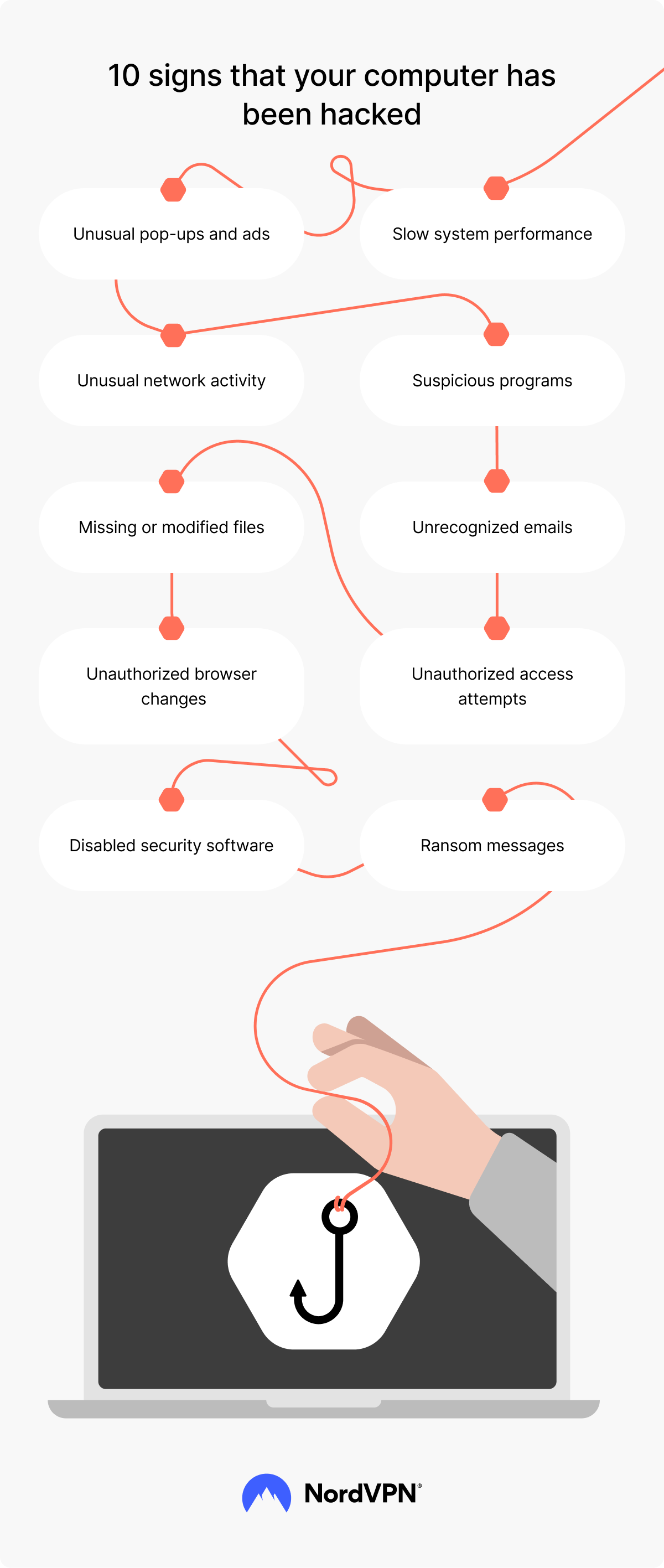Is my computer hacked?
Hackers seek to gain control of your devices and steal your information, identity, or money. Although hackers are a severe cybersecurity issue, you can do a few things to protect your computers and sensitive information. This article will tell you more about how to notice that someone has hacked your computer, what to do in case of a cyber breach, and how to protect your computer.
Contents
10 signs that your computer has been hacked
The signs of a cyberattack can be subtle, but observing and keeping the following warnings in mind might help you detect a breach on your computer and prevent further damage.

1. Unusual pop-ups and ads
Suspicious pop-ups ads, and fake antivirus messages usually appear in your browser or on your desktop. They might promote fishy services, unfamiliar websites or offer to download antivirus and other software programs. If you receive such notifications, it might indicate that your computer has been infected with malware. Never click on these random pop-ups.
2. Slow performance
If your computer’s performance suddenly decreases, it might be due to malware running in the background or unauthorized programs consuming system resources. Slow performance usually manifests in an extended operating system startup, increased program loading time, and system freezes or lags.
3. Unusual network activity
Unrecognized spikes in network activity could mean that your computer is part of a botnet or that malware on your device is communicating with a remote server. Monitor your computer’s data usage. If your computer is infected, monitoring may reveal unauthorized processes or software running in the background.
4. Suspicious programs
Finding fishy programs on your computer could be another sign of malware infection. Users usually download malicious software with legitimate programs, or it reaches the device through security loopholes. Also, pay attention to programs that start up when you turn on your computer. Monitor your system’s activity to identify an infection if you notice unknown apps.
5. Missing or modified files
If you notice missing or modified files on your computer, this might indicate that a hacker has gained access to your system. Such unauthorized alterations may affect your system’s stability or leak personal information to third parties. If you notice changes you didn’t make, investigate further to prevent collateral damage.
6. Unrecognized emails
Sometimes hackers use email to spread malware or phishing scams. If friends or colleagues report suspicious emails from your email address that you didn’t send, it may be a sign that your email account or device was compromised.
7. Browser changes
Another sign of infection in your computer system can be a change in browser settings. This includes changes to your homepage or search engine or the appearance of unwanted toolbars and extensions. Such changes usually redirect you to malicious websites stuffed with ads, malware, or sites that may potentially gather your personal information. A slow and unstable browser can also signal malware on your system.
8. Disabled security software
Sometimes hackers disable your antivirus to make their intrusion less noticeable. It leaves your computer vulnerable to various cyber threats, such as malware, viruses, or phishing attacks, which may lead to unauthorized access to your details (passwords, bank details).
9. Unauthorized access attempts
Receiving alerts about logins from unknown locations should be alarming and could mean someone is trying to hijack your online accounts. Hackers who gain access to your accounts may capture your sensitive data and use it to obtain financial information or personal communications, which can lead to financial fraud or identity theft.
10. Ransom messages
Suppose you get locked out of your files or systems and receive a message demanding payment to restore access – that indicates that you’ve become a victim of a ransomware attack. Such messages may appear as a pop-up or on your desktop background. Never pay the ransom – there’s no guarantee you’ll regain stolen data access.
What are the risks of computer hacking?
Once an intruder hacks your computer, they gain unauthorized access to your internal systems and personal information. This means that you may lose sensitive data, have your identity stolen, or suffer financial loss. However, the actual consequences of computer hacking usually depend on the nature of the attack and the hacker’s intent.
One of the main aftereffects of computer hacking is losing personal information, such as login credentials to your social media or bank accounts. Hackers can use your identifying information to engage in fraudulent activity or make unauthorized transactions resulting in financial loss.
Sometimes hackers deploy ransomware onto victims’ systems that infiltrates files, encrypts them, and then demands ransom to unlock them. In some cases, hackers creep onto systems to monitor online activity, compromising users’ privacy. Another risk of computer hacking is that your computer may become a part of a botnet and be used for distributed-denial-of-service (DDoS) attacks or to distribute malware to other devices.
Computer hacking threatens individuals, businesses, and even entire governments. As our reliance on technology grows, it is crucial to understand the threats that come with hacking. The more vigilant you are, the less likely you will be to fall victim to hackers.
What to do if your computer has been hacked
Realizing that your computer has been hacked can be overwhelming. However, there are some safety precautions that you can take to minimize the damage. Here’s a step-by-step guide to follow if you’ve noticed signs of hacking on your system:
- Disconnect from the internet. First, you should disconnect your computer from the internet and close the gate to further malware.
- Change your passwords. Act quickly and change your passwords from another device. Start with email and financial accounts. And don’t forget to change your Wi-Fi password.
- Scan your computer for malware and viruses. Run a full system scan with a reputable, up-to-date anti-malware tool or other security software to identify and eliminate the threat.
- Review files, folders, and system settings for unauthorized changes. Immediately check if the hacker has changed your files without your knowledge. If you find locked files demanding ransom, never pay. There’s no guarantee that you will regain access.
- Enable a firewall. Enable your firewall to monitor the incoming and outgoing network traffic.
- Monitor your financial and personal accounts for suspicious activity. Keep an eye on your bank and credit card statements for suspicious activity. If you notice odd activity, contact your financial institution immediately.
- Back up your files to an external hard drive or cloud. Putting your files and documents into external storage or the cloud ensures they’re safe and sound, protecting them from further damage.
- Seek professional cybersecurity advice. Sometimes recovering from the damage caused by hackers requires technical expertise. Turn to cybersecurity experts to ensure the malware doesn’t spread further.
Remember — knowledge is power. The more you’re aware of what to do in case of hacking, the faster you can eliminate the consequences.
How to protect your computer from future attacks
Because the threats lurking online continuously evolve, introducing new vulnerabilities and attack methods, it’s essential to take the necessary precautions before a hacker runs an attack on your systems. Here’s a list of security measures you can take to prevent malware attacks on your computer:
- Keep your operating system up to date. Regularly update your operating system and other software. Updates usually contain the latest security patches for existing vulnerabilities and reduce the risk of a breach.
- Use unique and strong passwords. Creating complex and unique passwords for online accounts may reduce the risk of a cyberattack significantly. Use a combination of uppercase and lowercase letters, numbers, and special characters, making it harder for computer hackers to access your personal or financial accounts. And never use the same password for multiple accounts.
- Use a VPN for Windows, Mac, or Linux. Hide your web traffic from prying eyes and raise your online security level with a VPN.
- Back up your data regularly. Regularly back up your important files and documents to external locations, such as cloud storage or hard drives. This will ensure you will not lose your data even if something goes wrong with your computer.
- Configure the firewall. A firewall helps you monitor incoming and outgoing network traffic based on your preferences. A properly configured firewall may prevent hacking and unauthorized access to your systems.
- Implement two-factor authentication. A two-factor authentication, or 2FA, adds an extra layer of security to various online accounts by requiring an additional authentication method other than a password. It may be a text message or an authenticator app.
- Use reliable antivirus software. Invest in quality antivirus software. It’s the cornerstone for detecting computer viruses and malware and providing real-time protection.
- Be wary of phishing emails. Always check the emails you receive. Even though an email seems legitimate, it may lead to a malicious website. Never click on those links or download suspicious email attachments.
- Get an attachment filter. NordVPN’s Threat Protection feature is designed to protect you from phishing attempts. It’s a security feature that keeps you safe while browsing and protects you from malware. It scans files during download and blocks malicious content before it reaches your device.
A combination of technology, vigilance, and knowledge is the way to increase your computer’s security against computer hackers. Implement these practices to build a robust defense against potential threats.

